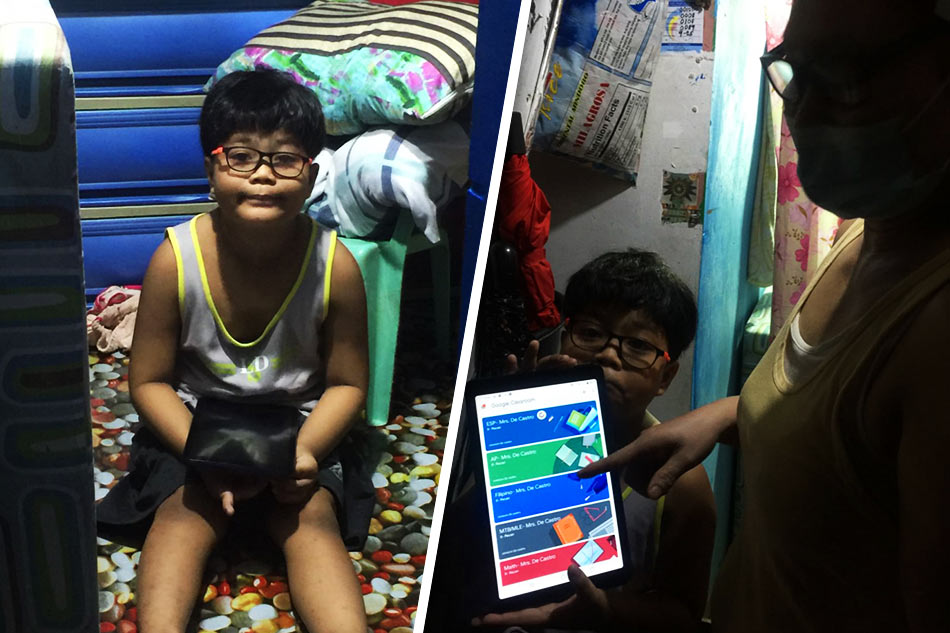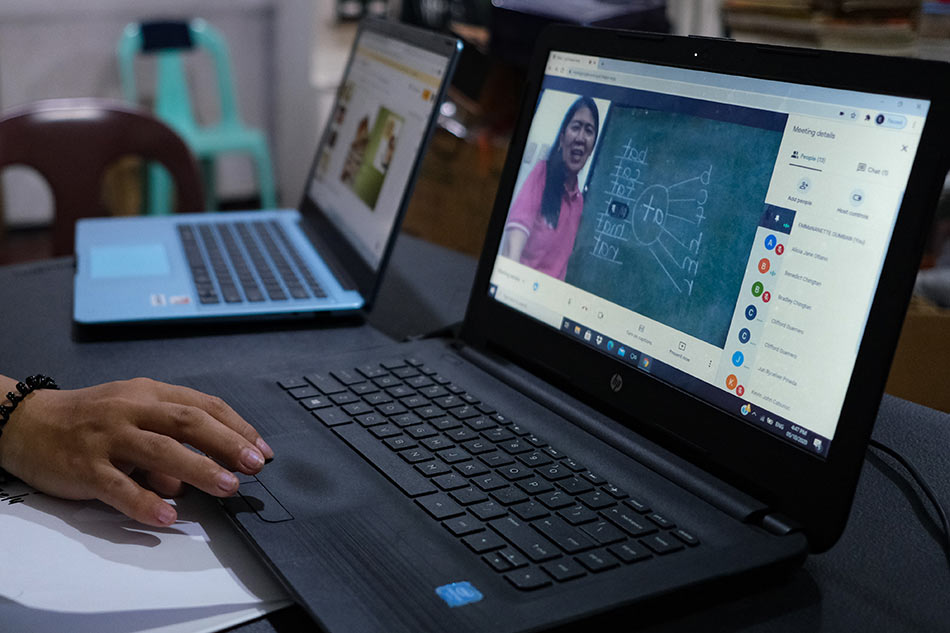Year into lockdown, some Manila public students say they’ve ‘adjusted’ to blended learning | ABS-CBN
ADVERTISEMENT

Welcome, Kapamilya! We use cookies to improve your browsing experience. Continuing to use this site means you agree to our use of cookies. Tell me more!
Year into lockdown, some Manila public students say they’ve ‘adjusted’ to blended learning
Year into lockdown, some Manila public students say they’ve ‘adjusted’ to blended learning
Ina Reformina,
ABS-CBN News
Published Mar 13, 2021 02:57 AM PHT
|
Updated Mar 13, 2021 12:09 PM PHT
MANILA—John Lawrence Quiachon, a Grade 2 public-school student in Manila, has now fully adjusted to blended learning amid the COVID-19 pandemic, according to his mother, Rose Quiachon.
MANILA—John Lawrence Quiachon, a Grade 2 public-school student in Manila, has now fully adjusted to blended learning amid the COVID-19 pandemic, according to his mother, Rose Quiachon.
Quiachon beamed as she told ABS-CBN News that her son’s grades for the first grading were all in the 80s, with 84 being the lowest.
Quiachon beamed as she told ABS-CBN News that her son’s grades for the first grading were all in the 80s, with 84 being the lowest.
“Dati po (pre-pandemic), may mga 90-plus siya. Ngayon, matataas pa rin, 80 and above . . . Nag-a-adjust pa po kasi siya noong first grading, sa first month. Ngayon, naka-adjust na po siya,” Quiachon said.
“Dati po (pre-pandemic), may mga 90-plus siya. Ngayon, matataas pa rin, 80 and above . . . Nag-a-adjust pa po kasi siya noong first grading, sa first month. Ngayon, naka-adjust na po siya,” Quiachon said.
Asked if he still gets confused with his self-learning modules and twice a week online classes, John Lawrence said, “OK na po lahat”.
Asked if he still gets confused with his self-learning modules and twice a week online classes, John Lawrence said, “OK na po lahat”.
ADVERTISEMENT
He even showed how he has already mastered accessing his subjects and modules in his local-government-issued tablet.
He even showed how he has already mastered accessing his subjects and modules in his local-government-issued tablet.
Sixth-grader JM Periña, who goes to the same public school as John Lawrence, said he is also now used to the “new normal”.
Sixth-grader JM Periña, who goes to the same public school as John Lawrence, said he is also now used to the “new normal”.
After being featured on TV Patrol on September 30, 2020, PUP Professor and Engr. Rene Tanasas gave JM a desktop computer set and Wi-Fi modem.
After being featured on TV Patrol on September 30, 2020, PUP Professor and Engr. Rene Tanasas gave JM a desktop computer set and Wi-Fi modem.
JM uses the computer twice a week for his online classes.
JM uses the computer twice a week for his online classes.
CONNECTIVITY PROBLEMS
When ABS-CBN News first spoke to JM and John Lawrence in September, their learning modules were still incomplete.
When ABS-CBN News first spoke to JM and John Lawrence in September, their learning modules were still incomplete.
ADVERTISEMENT
Now, they both say the modules, both in soft and hard copies, were distributed on time by their teachers.
Now, they both say the modules, both in soft and hard copies, were distributed on time by their teachers.
There remains one problem, however: internet connectivity.
There remains one problem, however: internet connectivity.
Quiachons and Periñas continue to share one “piso Wi-Fi” vendo machine with several other households.
Quiachons and Periñas continue to share one “piso Wi-Fi” vendo machine with several other households.
“P5 every two hours, patayin namin data (tablet SIM card), maghulog kami P5 doon (vendo machine) para umandar ang Wi-Fi,” Quiachon said, as she explained that John Lawrence was issued a SIM card that has poor signal in their area.
“P5 every two hours, patayin namin data (tablet SIM card), maghulog kami P5 doon (vendo machine) para umandar ang Wi-Fi,” Quiachon said, as she explained that John Lawrence was issued a SIM card that has poor signal in their area.
Despite this challenge, both students never considered dropping out of school.
Despite this challenge, both students never considered dropping out of school.
ADVERTISEMENT
JM, whose father is a tricycle driver, is determined to pass all his subjects.
JM, whose father is a tricycle driver, is determined to pass all his subjects.
“Para po makapagtapos po ako ng pag-aaral at matulungan ko tatay at nanay ko,” JM said.
“Para po makapagtapos po ako ng pag-aaral at matulungan ko tatay at nanay ko,” JM said.
INCREASE IN ENROLLMENT
The Alliance of Concerned Teachers (ACT) earlier predicted a massive number of student dropouts, citing a declining attendance in online classes and reports of unclaimed or unanswered modules.
The Alliance of Concerned Teachers (ACT) earlier predicted a massive number of student dropouts, citing a declining attendance in online classes and reports of unclaimed or unanswered modules.
Students who still have no access to gadgets for online classes have the option of learning through printed modules.
Students who still have no access to gadgets for online classes have the option of learning through printed modules.
However, despite the pandemic, the latest data from the Department of Education (DepEd) show a 6.48% increase in the number of basic education students from October 31, 2020, when classes began, to January 15, 2021, as the DepEd allowed late enrollment.
However, despite the pandemic, the latest data from the Department of Education (DepEd) show a 6.48% increase in the number of basic education students from October 31, 2020, when classes began, to January 15, 2021, as the DepEd allowed late enrollment.
ADVERTISEMENT
As of January 15, the number of enrolled students ballooned to 26,657,411, or an increase by 1,621,751, compared to 25,035,660 public, private, and alternative learning system (ALS) students in October 2020.
As of January 15, the number of enrolled students ballooned to 26,657,411, or an increase by 1,621,751, compared to 25,035,660 public, private, and alternative learning system (ALS) students in October 2020.
The number of private school students increased by 51.76%, or by 1,151,305 students, bringing the January 15, 2021 figure to 3,375,748, from 2,224,443 in October.
The number of private school students increased by 51.76%, or by 1,151,305 students, bringing the January 15, 2021 figure to 3,375,748, from 2,224,443 in October.
The number of public school students also increased by 366,250 or by 1.64%, with the total number of public school students at 22,712,409, from 22,346,159 last October.
The number of public school students also increased by 366,250 or by 1.64%, with the total number of public school students at 22,712,409, from 22,346,159 last October.
ALS students, meanwhile, rose by 6.05%, or by 24,545; 430,399 ALS students were recorded in January, from 405,854 last October.
ALS students, meanwhile, rose by 6.05%, or by 24,545; 430,399 ALS students were recorded in January, from 405,854 last October.
While formal education is classroom-based and managed by trained formal teachers, the ALS program happens outside the classroom. It is flexible when it comes to time, and community-based — conducted at community learning centers, barangay multi-purpose halls or at home.
While formal education is classroom-based and managed by trained formal teachers, the ALS program happens outside the classroom. It is flexible when it comes to time, and community-based — conducted at community learning centers, barangay multi-purpose halls or at home.
ADVERTISEMENT
The DepEd had explained that students “shifted from one mode of learning to another or migrated from one geographical location to another,” and a “slow return of students to schools after holiday season and school vacations is typically observed annually”.
The DepEd had explained that students “shifted from one mode of learning to another or migrated from one geographical location to another,” and a “slow return of students to schools after holiday season and school vacations is typically observed annually”.
“Learners’ migration is observed due to the economic impact of the pandemic. Data showed that students have either moved from city to provincial schools or from private to public schools. Other learners, meanwhile, have decided to shift from solely modular to blended learning, wherein they can also tap into TV, online, and radio resources available at their respective schools,” the DepEd said in a statement.
“Learners’ migration is observed due to the economic impact of the pandemic. Data showed that students have either moved from city to provincial schools or from private to public schools. Other learners, meanwhile, have decided to shift from solely modular to blended learning, wherein they can also tap into TV, online, and radio resources available at their respective schools,” the DepEd said in a statement.
RELATED VIDEO
Read More:
coronavirus
COVID-19
one year lockdown
education
blended learning
distance learning
DepEd
Department of Education
ADVERTISEMENT
ADVERTISEMENT




